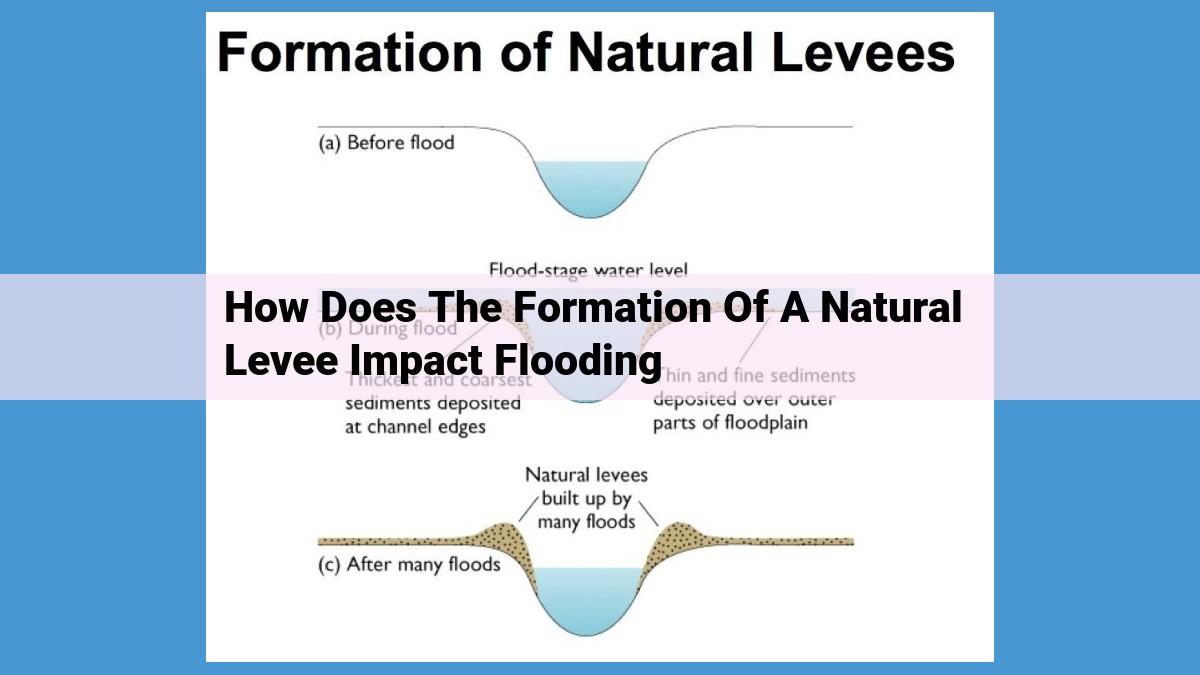Natural levees form as sediment accumulates from flooding, creating natural embankments along rivers. Levees reduce riverbank overflow by confining floodwaters within the channel, offering floodplain protection by preventing water spread. They mitigate backwater effects by minimizing upstream floodwater accumulation. Formation involves sediment deposition and accumulation, influencing channel morphology, riverbank stability, floodplain development, and the backwater effect.
Levee Formation: Sculpting the River Landscape
In the meandering embrace of rivers, where the relentless flow carves its path through the land, a remarkable natural phenomenon unfolds: the birth of levees. These towering embankments, guardians of the riverbanks, emerge from the unceasing rhythm of floodwaters. As floodwaters surge over the river’s banks, they carry with them a sediment-laden cargo. This sediment settles and accumulates along the river’s edge, slowly building up over time. Grain by grain, the sediment forms a nascent levee, a natural barrier that separates the river’s channel from its surrounding floodplain.
As the river continues to ebb and flow, the levee steadily grows in height and stature. Each successive flood adds its layer of sediment, reinforcing the levee’s structure and solidifying its role as a natural protector. Over time, these once-humble embankments mature into formidable guardians, safeguarding the land from the river’s wrath.
Levee Impact on Flooding
Levees, or natural embankments along rivers, play a crucial role in mitigating flooding and protecting riparian communities. Their impact is evident in several key aspects:
Confinement of Riverbank Overflow
Levees act as barriers that contain floodwaters within the river channel, preventing them from overflowing onto adjacent riverbanks. This containment ensures that floodwaters remain confined to a designated area, reducing the risk of inundation and damage to nearby properties and infrastructure.
Floodplain Protection
Levees serve as a first line of defense against flooding by preventing floodwaters from spreading over low-lying floodplains. They create a physical barrier that diverts floodwaters away from vulnerable areas, safeguarding communities from the devastating effects of floods. Levees provide a safety buffer, giving residents time to evacuate and protect their belongings.
Mitigation of Backwater Effect
The backwater effect refers to the upstream accumulation of floodwaters due to obstructions downstream. Levees help mitigate this effect by minimizing the amount of floodwaters that flow upstream. They provide a regulated outlet for floodwaters, preventing excessive accumulation and reducing the risk of flooding in upstream areas.
By effectively addressing these flooding concerns, levees play a vital role in safeguarding communities and ecosystems from the destructive forces of floodwaters. Their presence enhances riparian safety, promotes economic stability, and contributes to the overall well-being of flood-prone regions.
Related Concepts in Levee Formation and Flooding
Understanding the complexities of levee formation and their impact on flooding requires exploring several related concepts:
Sediment Deposition and Accumulation
Levees are natural embankments formed by the accumulation of sediments carried by floodwaters. As rivers overflow their banks during floods, sediments settle along the river’s edge, gradually building up over time. These sediments can range from fine silts to coarse gravels, depending on the river’s characteristics.
Influence on Channel Morphology
Levees significantly influence the morphology (shape and form) of the river channel. By confining floodwaters within the channel, levees prevent lateral erosion and promote sedimentation, resulting in a narrower and deeper cross-section.
Impact on Riverbank Stability
The presence of levees strengthens riverbanks by protecting them from the force of floodwaters. Without levees, riverbanks are more susceptible to erosion, leading to undercutting and collapse.
Alteration of Floodplain Development
Levees significantly alter the characteristics of floodplains. By confining floodwaters to the main channel, levees prevent them from spreading over adjacent floodplains. Consequently, floodplains downstream of levees experience reduced flooding, resulting in altered vegetation, habitat, and land use patterns.
Concept of the Backwater Effect
The backwater effect refers to the rise in floodwaters upstream of a constriction, such as a levee. Levees can reduce the backwater effect by minimizing the accumulation of floodwaters upstream. This helps to mitigate flooding and protect areas located upstream of the levee.
